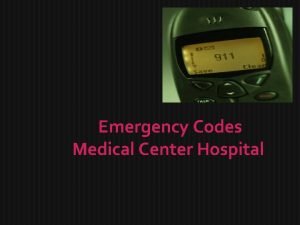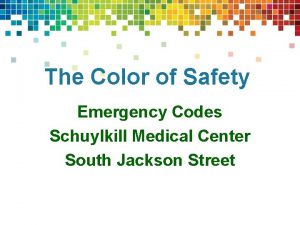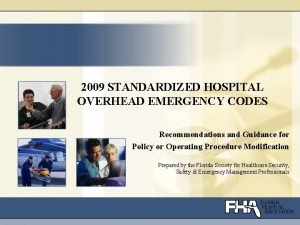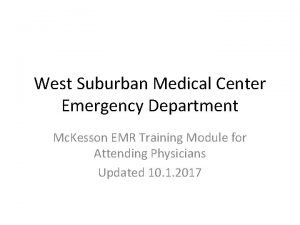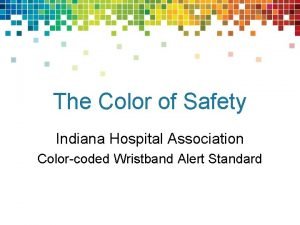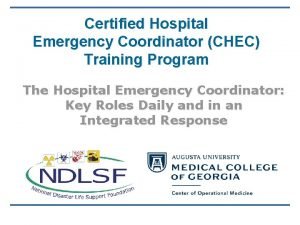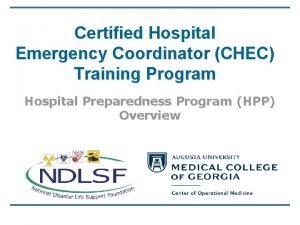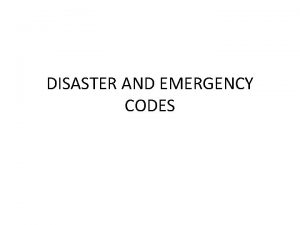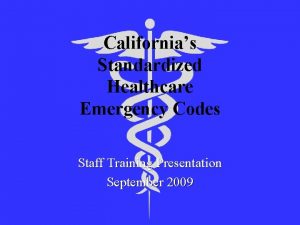2009 STANDARDIZED HOSPITAL OVERHEAD EMERGENCY CODES Recommendations and

























- Slides: 25

2009 STANDARDIZED HOSPITAL OVERHEAD EMERGENCY CODES Recommendations and Guidance for Policy or Operating Procedure Modification Prepared by the Florida Society for Healthcare Security, Safety & Emergency Management Professionals

Acknowledgements • The Florida Society for Healthcare Security, Safety & Emergency Management Professionals would like to thank the following organizations for their assistance in the preparation of these recommendations and guidelines: – – Florida Hospital Association South Florida Hospital and Healthcare Association Florida Organization of Nurse Executives Florida Society for Healthcare Risk Management and Patient Safety – International Association for Healthcare Security and Safety – Florida Healthcare Engineering Association

Executive Summary • Background – 2002: • A survey of hospitals' emergency codes illustrated the lack of uniformity existing among hospitals and allied healthcare organizations in Florida. • Florida Society for Health Security and Safety Professionals (FSHSS), representing over 100 hospitals and health care systems in Florida, recommended a standardized Emergency Code system for hospitals.

Executive Summary • 2003: • A working group of healthcare security and safety professionals selected and recommended code identifiers for use in Florida hospitals and other healthcare organizations. § § § RED - Fire § BLUE – Cardiac / Respiratory Arrest § PINK – Infant / Child Abduction § BLACK - Bomb § ORANGE - Hazmat / Bioterrorism § GREY - Violence/Security Alert WHITE - Hostage YELLOW - Lockdown GREEN - Mass Casualty / Disaster BROWN - Severe Weather

Executive Summary • While the main colors were constant, flexibility was built into the system for individual hospital needs. • The goal is to have a common set of base colors allowing for customization.

Executive Summary • Five years have passed since the development of the 2003 Standardized Hospital Emergency Code for the State of Florida. • A 2008 Working Group: examined current standard codes being used by Florida and other state’s hospitals and healthcare systems; assessed the need for additional changes promoting uniformity; and, cross-walked the information with related healthcare associations and groups.

Executive Summary • NOTE: The Working Group combined colors, code number and specific language to an all “color” system. • This system acknowledges that healthcare workers routinely work at more than one healthcare entity but may be required to remember and respond to different codes. Standardizing codes supports employees at all Florida healthcare entities.

2009 Recommendations

Code Black • Bomb Threat – The majority of hospitals are using Code Black as the designation for a bomb threat.

Code Green • Disaster Plan Activation – Code Green was selected because green means go! – A disaster plan needs to be activated quickly for effective response.

Code Red • Fire – Code Red is a national standard recommended by the Hospital Fire Marshall’s Association and its membership.

Code Orange • Hazardous Materials – There was consensus for the use of Code Orange indicating a hazardous material incident. – Not just for the activation of the decontamination team but other incidents involving hazardous materials.

Code Blue • Medical Emergency – A majority of healthcare entities are using Code Blue for cardiac and/or respiratory arrest.

Code Blue 13 • Medical Emergency – Code Blue 13 is used in some counties to denote that the Code Blue is for a pediatric “code. ”

Code Pink • Infant / Child Abduction – Code Pink is also used by many organizations to inform employees regarding an abduction attempt.

Code Pink • Infant / Child Abduction – Please consider adding Code Pink with an age to differentiate between a infant and pediatric patient. • Example: Code Pink 2 – is a two year old – this helps staff adjust to looking for a toddler vs. an infant that may be concealed in a bag or suitcase.

Code Pink • Infant / Child Abduction – The National Center for Missing and Exploited Children has issued Volume 9 of the Healthcare Guidelines. – This is the first update since 2005.

Code Silver • Active Shooter – Code Silver is a new code added as hospitals are starting to experience more of these events on their campuses.

Code Silver • This code is similar to the Silver Alert for a missing elderly individual in the community. • Why was the same color code used? – Healthcare is a unique environment; – There’s a national consensus among hospital codes; – It is intended to be used in hospitals primarily to inform healthcare workers about a potential situation – not the public.

Code White • Hostage Situation – Question: Is this emergency code the same as a Code Silver? – Answer: No!

Code White • An active shooter is ". . . an armed person who has used deadly physical force on other persons and continues to do so while having unrestricted access to additional victims. “ – • Active shooters have caused a paradigm shift in law enforcement training and tactics, especially as these persons do not necessarily expect to escape or even survive these situations. A hostage is a person or entity which is held by a captor.

Additional Information • U. S. Department of Justice (DOJ): http: //www. usdoj. gov • DOJ, Office of Juvenile Justice and Delinquency Prevention: http: //ojjdp. ncjrs. org/ • Hospital Fire Marshall’s Association, Inc. : http: //hfma. tripod. com/ • National Center for Missing and Exploited Children: http: //www. missingkids. com • International Association for Healthcare Security & Safety: http: //www. iahss. org • South Florida Hospital and Healthcare Association: http: //www. sfhha. org

Additional Information • Florida Organization of Nurse Executives: http: //www. fonexo. com/ • Florida Healthcare Engineering Association: http: //www. fhea. org/ • Association of Women’s Health, Obstetric and Neonatal Nurses: http: //www. awhonn. org/awhonn/ • National Association of Neonatal Nurses: http: //www. nann. org/ • The Academy of Neonatal Nursing: http: //www. academyonline. org/ • Florida Hospital Association: http: //www. fha. org • Florida Department of Law Enforcement (Silver Alerts): http: //www. fdle. state. fl. us/Content/getdoc/f 7 d 5482 a-571 a-445 a -84 b 2 -f 1 a 1 a 01 f 599 d/Silver-Alerts. aspx

Questions & Answers • For further information contact: – John Wilgis, MBA, RRT Director, Emergency Management Services Florida Hospital Association 407 -841 -6230 john@fha. org

Thank you!
 Hospital codes
Hospital codes Code green hospital
Code green hospital Biaya overhead aktual adalah
Biaya overhead aktual adalah Standardized emergency management system
Standardized emergency management system Hospital codes colors
Hospital codes colors West suburban hospital emergency room
West suburban hospital emergency room Limb alert bracelet hospital
Limb alert bracelet hospital Certified hospital emergency coordinator
Certified hospital emergency coordinator Miemss hospital codes
Miemss hospital codes Chec certification
Chec certification Chec training
Chec training Location and layout of hospital pharmacy
Location and layout of hospital pharmacy Methods and metrics for cold-start recommendations
Methods and metrics for cold-start recommendations Q e t in ipcr
Q e t in ipcr Giving opinions en español
Giving opinions en español Asking and giving advice
Asking and giving advice Making suggestions and recommendations
Making suggestions and recommendations Conclusion of lamb to the slaughter
Conclusion of lamb to the slaughter Standard recipe costing
Standard recipe costing Mudaliar commission members
Mudaliar commission members Recommendations of npe 1986
Recommendations of npe 1986 Nap 6 recommendations
Nap 6 recommendations Nap 6 summary
Nap 6 summary Anaphylaxis treatment
Anaphylaxis treatment Jj irani committee recommendations
Jj irani committee recommendations The kothari commission
The kothari commission
